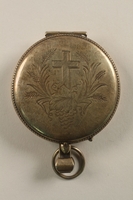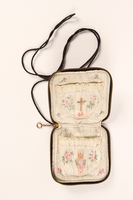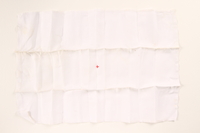Overview
- Brief Narrative
- Sterling silver altar bread host engraved IHS, a monogram for the name of Jesus Christ (Iesous Christos), used by Father Edward Henry, a chaplain in the United States Army in Europe during World War II. A pyx is a vessel used to transport consecrated communion host. As a Catholic priest, he carried a portable Mass kit to administer last rites, to offer communion, and to perform mass for the troops. Father Henry and his unit took part in the liberation of Paris on August 25, 1944. He was one of the first American priests to hold mass in the Cathedral Notre Dame de Paris after liberation.
- Date
-
use:
1944-1945
- Geography
-
use:
Paris (France)
- Credit Line
- United States Holocaust Memorial Museum Collection, Gift of the Estate of Edward Henry
- Contributor
-
Subject:
Edward C. Henry
- Biography
-
Edward C. Henry was born in 1912 in Trenton, New Jersey, the youngest of 10 children. He graduated from Our Lady of Angels Seminary at Niagara University in New York. He was ordained to the priesthood on March 13, 1937. He enlisted in the United States Army and served as a chaplain in Texas, England, and France.
On August 25, 1944, Father Henry and his regiment assisted in the liberation of Paris soon after the landings in Normandy that June. In reflecting upon his service as an army chaplain, he noted that "it was hard to get used to," as soldiers "half alive would come in and you try to ease their last moments." He was one of the first American priests to say mass at the Cathedral of Notre Dame post liberation. Father Henry traveled throughout France, performing last rites, saying mass, and administering communion to the troops.
After the war, he returned to New Jersey and led three congregations prior to retiring in 1970. He died in 1999, age 87 years old.
Physical Details
- Language
- Latin
- Classification
-
Christian Art and Symbolism
- Category
-
Ceremonial containers
- Object Type
-
Pyxes (aat)
- Physical Description
- Circular silver metal communion host container. The hinged lid has a raised, rope border design. The center lid exterior has engraved text over a patterned background encircled by wavy lines. Triangular and circular tabs are soldered to the top edge of the lid at the 12 and 1 o’clock positions. A rectangular stem with a curved top and straight sided bow engraved with a curvilinear design is attached to the back. A circular, flat topped crown with vertical grooves is soldered to the top of the concave base. To open, the crown is pushed down and the tabs are pulled forward. The interior is gold plated.
- Dimensions
- overall: Height: 2.750 inches (6.985 cm) | Width: 1.875 inches (4.763 cm) | Depth: 1.625 inches (4.128 cm)
- Materials
- overall : silver, gold
- Inscription
- lid, top, ornate script, engraved : IHS [monogram for Ieosus Christos, Jesus Christ]
Rights & Restrictions
- Conditions on Access
- No restrictions on access
- Conditions on Use
- No restrictions on use
Keywords & Subjects
Administrative Notes
- Legal Status
- Permanent Collection
- Provenance
- The pyx was donated to the United States Holocaust Memorial Museum in 2010 by John Grasser and Linda Layton, on behalf of the Estate of Edward Henry.
- Funding Note
- The cataloging of this artifact has been supported by a grant from the Conference on Jewish Material Claims Against Germany.
- Record last modified:
- 2023-09-01 09:04:14
- This page:
- https://collections.ushmm.org/search/catalog/irn43119
Download & Licensing
In-Person Research
- By Appointment
- Request 21 Days in Advance of Visit
- Plan a Research Visit
- Request to See This Object
Contact Us
Also in Edward Henry collection
The collection consists of artifacts and photographs relating to the experiences of Edward Henry, a chaplain in the United States Army during World War II in England and France, where his unit participated in the liberation of Paris.
Date: 1944-1964

Sterling silver communion host pyx engraved with a cross, wheat, and a grape cluster used by a US Army chaplain
Object
Sterling silver, engraved altar bread host used by Father Edward Henry, a chaplain in the United States Army in Europe during World War II. A pyx is a vessel used to transport consecrated communion host. As a Catholic priest, he carried a portable Mass kit to administer last rites, to offer communion, and to perform mass for the troops. Father Henry and his unit took part in the liberation of Paris from Nazi Germany on August 25, 1944. He was one of the first American priests to hold mass in the Cathedral Notre Dame de Paris after liberation.

Brown leather burse and sheet of prayers used by US Army chaplain
Object
Satin lined leather burse, or case, used to carry ceremonial items used for Mass by Father Edward Henry, a chaplain in the United States Army in Europe during World War II. A sheet with prayers and the Rite of Eucharistic Devotion from 1964 was later stored in the burse. As a Catholic priest, Father Henry carried a portable Mass kit to administer last rites, to offer communion, and to perform mass for the troops. His unit took part in the liberation of Paris on August 25, 1944. He was one of the first American priests to hold mass in the Cathedral Notre Dame de Paris after liberation.

Brown leather laced burse with embroidered satin pockets, a purificator, and a small cloth used by a US Army chaplain
Object
Leather burse, or case, with laced side flaps and two pockets, used to carry ceremonial items used for Mass by Father Edward Henry, a chaplain in the United States Army in Europe during World War II. As a Catholic priest, Father Henry carried a portable Mass kit to administer last rites, to offer communion, and to perform mass for the troops. He also carried a purificator, used to wipe the chalice after each use during communion, and the small cloth, which may have been used as a finger towel. A chaplain's Mass kit may include many other items, but it is adapted depending on where it may be used. Father Henry and his unit took part in the liberation of Paris on August 25, 1944. He was one of the first American priests to hold mass in the Cathedral Notre Dame de Paris after liberation.
Edward Henry photographs
Document
Contains photographs illustrating Edward C. Henry's experiences during and after World War II as a Catholic chaplain in the United States Army. Includes black-and-white images depicting his army unit as well as Signal Corps imagery of Buchenwald and Dachau concentration camps shortly after liberation. Also includes numerous images of bomb-damaged towns and cathedrals in France.



